LabAdviser/314/Preparation 314-307
Feedback to this page: click here
Optical Microscopes
1) Olympus BX51 colorview.
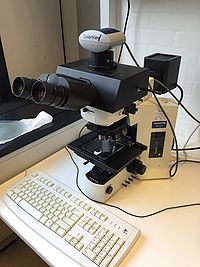
2) Olympus SZ61 stereo Zoom Microscope.

3) Leica MZ75 stereo microscope.
File:Operation Manual Leica_MZ75.pdf

Ion milling
1) Fischione Low Angle Ion Milling and Polishing System Model 1010. The Fischione Ion Mill is used for producing TEM specimens with large electron transparent areas. Samples are pre-thinned by e.g. mechanical grinding and polishing or chemical polishing. The milling or polishing is performed by argon ions. The instrument has two independently adjustable Hollow Anode Discharge (HAD) argon ion sources, which can be operated from 0.5 to 6.0 kV with currents from 3 mA to 8 mA. The milling angle can be adjusted in the range of 0° to 45°. Tuning the milling parameters allows for coarse or gentle milling and the goal is to get clean samples free of physical or chemical artifacts
File:Operation Manual Fischione_1010.pdf

.
2) Fischione NanoMill model 1040. This TEM specimen preparation system is an excellent tool for creating the high-quality thin specimens needed for advanced transmission electron microscopy imaging and analysis. It is ideal for both post-FIB (focused ion beam) processing and the enhancement of conventionally prepared specimens.

Pumping stations
1) Pumping Cube for single TEM specimen holder.
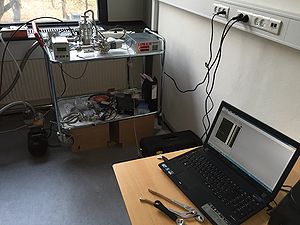
2) Gatan Turbo Pumping Station model 655. Capacity 4 specimen holders.
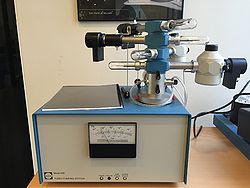
Polishing
1) Struers Labopol -25.

2) TechPrep Allied.

3) Struer Labopol -5.

4) Struer Labopol -4.

Saws
1) Struers Minitom.

2) Well Precision Diamond Wire Saw.

Plasma cleaner & Pumping Station
1) Fischione Plasma Cleaner model 1020.
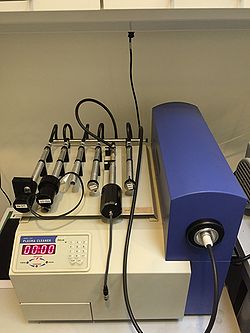
.
Coaters & Accessories
1) Cressington 208 Carbon Coater.

2) Cressington 208HR Sputter Coater.

Accessory for 208HR Sputter Coater:
Glow Discharge Head

Sonicators
1) Ultrasonic Branson 2510.

2) VWR Ultrasonic Cleaner.
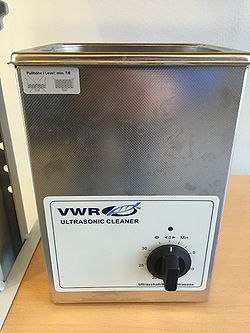
Hot plates
1) Nuova hot plate.
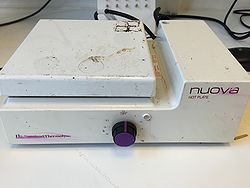
Plunger
The FEI Vitrobot™ is used for vitrifying (freezing) single particle samples for cryo-TEM. The Vitrobot™ is fully automated and performs the cryo-fixation process at constant conditions (temperature, relative humidity, blotting and freezing velocity), which ensures high quality cryo-fixation. The sample is pipetted on a TEM grid, blotted and then plunged in liquid ethane, which is cooled with liquid nitrogen. The FEI Vitrobot™ Data Sheet is here File:Vitrobot_Mark_IV_Datasheet.pdf and an example of the APV can be found here File:APV_Vitrobot.pdf. The Vitrobot™ is located in building 314, in the Soft Mater (toxic) Lab. For further information on the machine usage contact ramona.mateiu@cen.dtu.dk.

Microtomes
Our RMC MT-7 Microtome is a vintage piece of equipment and can be used for planning specimens for SEM/EDX and/or for cutting relative thin slices (approx. 200nm thick) for TEM. First, the specimen needs to be embedded into a resin or an epoxy, and then can be sliced with a glass or diamond knife. At DTU Cen we can offer only glass knifes. The APV for the RMC MT-7 Microtome can be found here File:APV RMC Microtome.pdf The RMC MT-7 Microtome is located in building 314, in the Soft Mater (toxic) Lab. For further information on the machine usage contact: ramona.mateiu@cen.dtu.dk.

Critical point dryer
Leica EM CPD300. The Critical Point Drier (CPD) is used for drying samples for the SEM. The machine uses the fact that at the critical point the solvent can be converted from liquid to gas without crossing the interfaces between liquid and gas (no surface tension) and hence no sample drying artefacts. CO2 is the solvent of choice as its triple point is suitable for biological samples (31°C and 74 bars). The CO2 is not miscible with water; therefore the sample should be dissolved in acetone or ethanol. The Leica EM CPD300 operating manual is here File:CPD030.pdf and the APV here File:APV- Critical Point Dryer.docx.
The Leica EM CPD300 is located at DTU Cen, building 314, in the Soft Mater (toxic) Lab. For further information on the machine usage contact ramona.mateiu@cen.dtu.dk.

Centrifuge
The Mini Spinner Eppendorf is a desktop centrifuge with supplied rotor with maximum speed/force 13,400rpm/12,100xG. It has a 30-minute timer, which is settable in 15-sec increments. It has a short-spin mode fixed at maximum speed. The Mini Spinner Eppendorf is located in building 314, in the Soft Mater (toxic) Lab. For further information on the machine usage contact: ramona.mateiu@cen.dtu.dk.

pH meter
If you are planning on doing chemical fixation on biological samples you will probably need to make buffers and use a pH-meter. The pH-meter is located in building 314, in the Soft Mater (toxic) Lab and it is dedicated to “Soft Matter” related work. For further information on the machine usage contact: ramona.mateiu@cen.dtu.dk.

